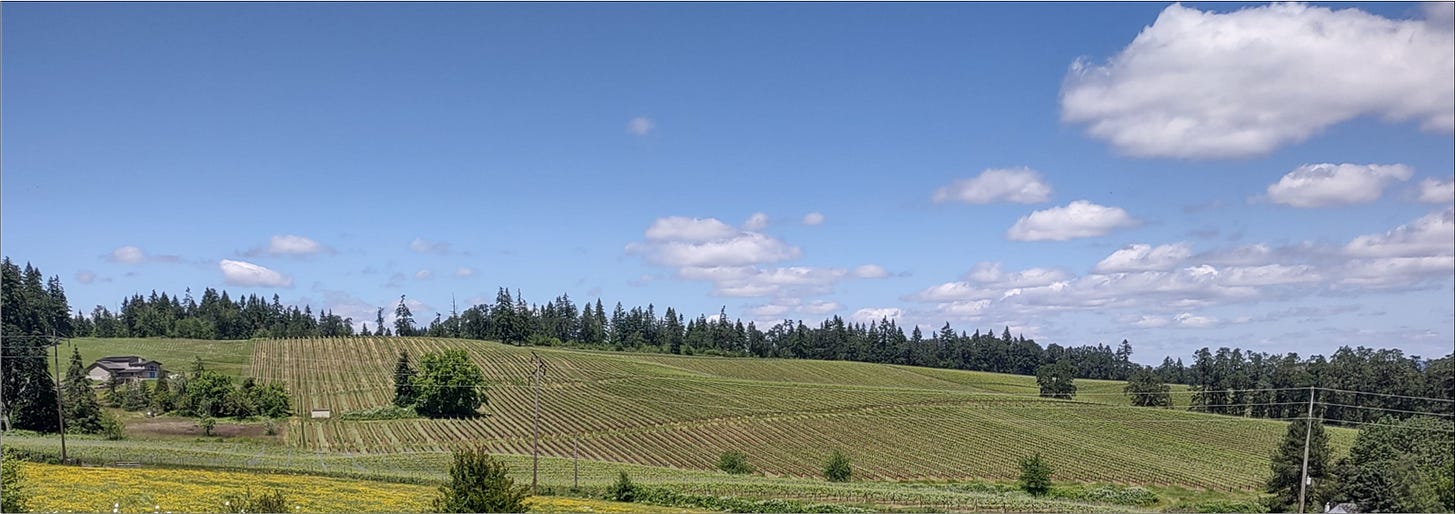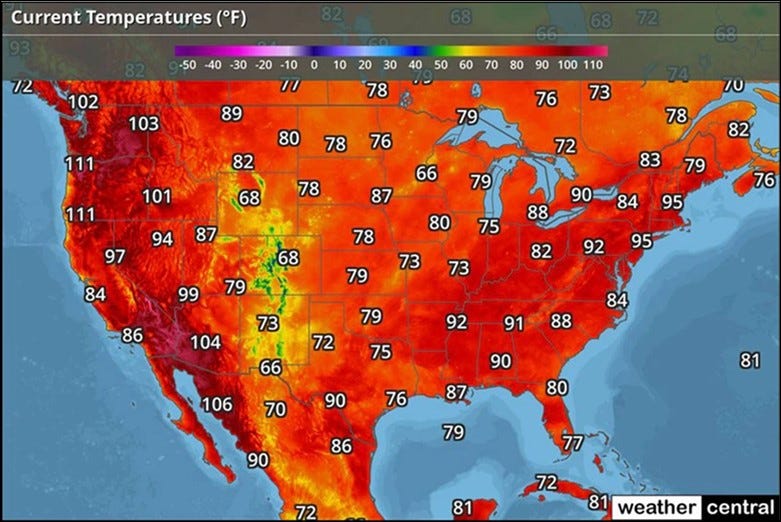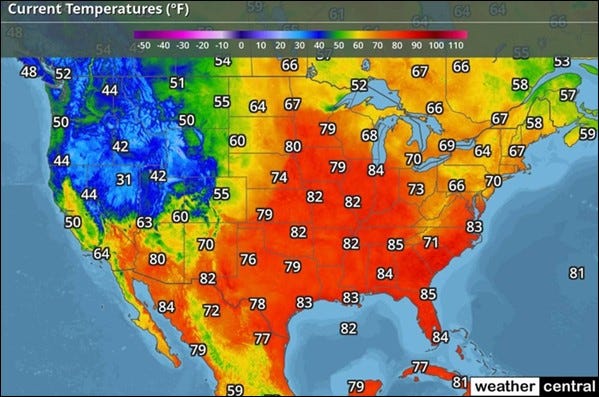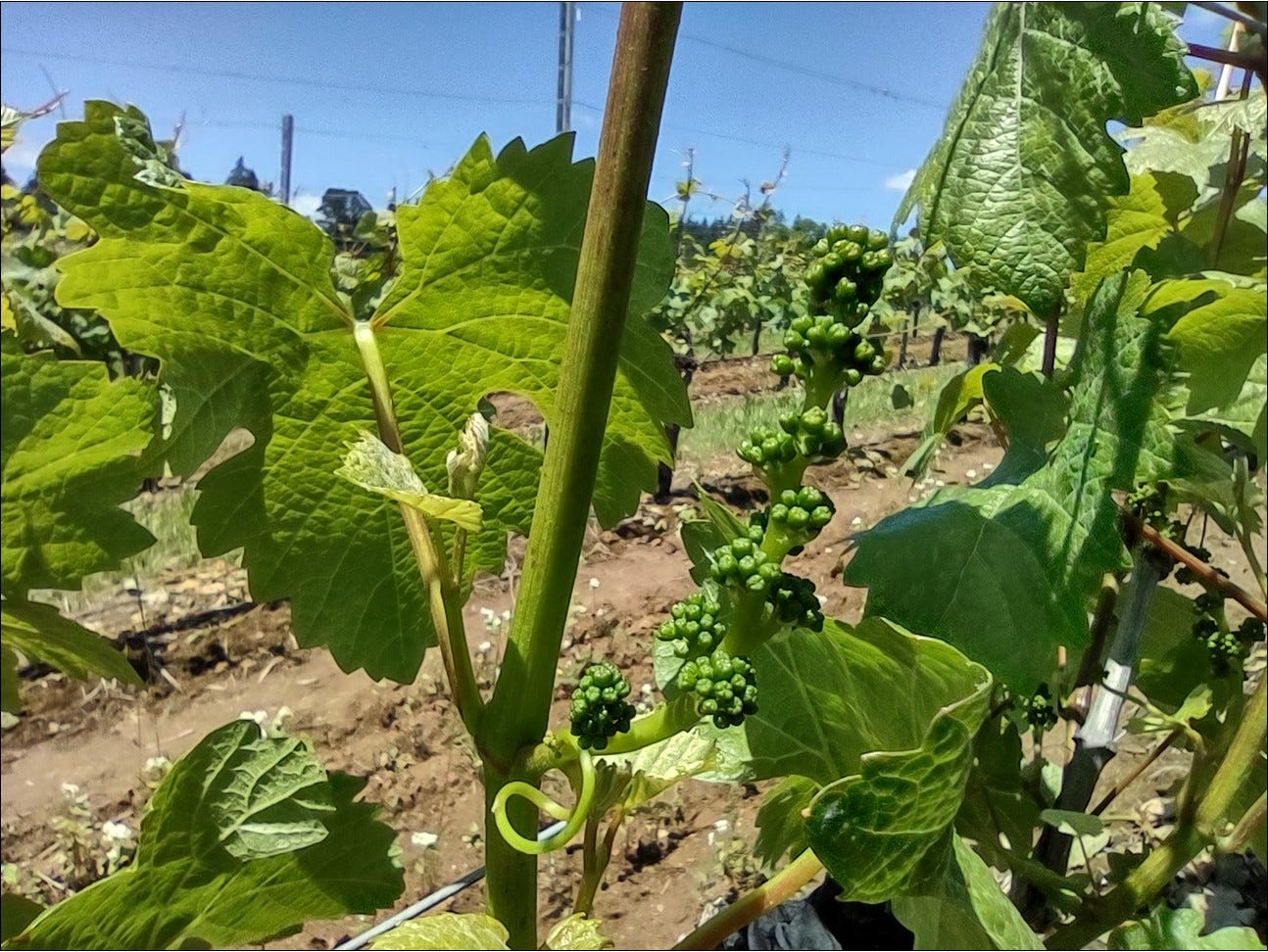Amalie Robert Estate Special Update: First Day of Summer
Hello and Welcome,
According to the calendar, June 21st is the first day of summer. If you grow Pinot Noir in the Willamette Valley, you may not believe that to be true. Well, who are you going to trust? The calendar or your own lying eyes? We may very well be channeling vintage 2011.
June has continued on with April and then May’s interpretation of Ketchikan, Alaska where it rains, on average, 234 days a year. Average yearly rainfall in Ketchikan is 140-160 inches, while the average in our sub-AVA of the Willamette Valley is about 35 inches and the United States averages 38 inches. Fortunately for us, our sedimentary Bellpine series soil is well drained so as not to waterlog our vines’ roots. They don’t like that.
The Big Picture
But the cover crops are living large on all of this rainfall. The buckwheat is flowering, providing plant-based protein in the form of pollen to our beneficial insects. They have a merciless task of eviscerating all of the undesirable insects that will do damage to our vines. We feed them well.
The common vetch is waiting on a few more heat units before it takes off. But still, it is growing roots that will soon be affixed with nitrogen nodules to feed our vines. We would like to take this opportunity to point out that wine is a plant-based product.
And the vines, they are doing what they can with what they’ve got. Once the weather does turn for the better, we are expecting a full-on burst of exponential growth. And all of that growth will need to be contained in three sets of catch wires, by hand.
Now, 35 acres of vines may not seem like a lot, but it represents about 209,000 lineal feet (39.5 miles) of trellis wires that need to be put up. And since there are wires on both sides of the row, that is now 79 miles of wires. And, and if you figure in that we have 3 sets of wires, now we have 237 miles of wires to contend with. Clearly, you can see how farming math gets away from you in a hurry.
Winemaking: The Continuation of Terroir by Other Means.® by Dena & Ernie is the repository of our farming history at Amalie Robert Estate. A FLOG communication (Farming bLOG).
We have over 200 posts going back some 20 years. It’s all out there. More than you would ever want to know about farming wine. Check us out on Substack. You can keep up with Vintage 2022 with our Instagram account @AmalieRobert. Estate grown, hand harvested Oregon Willamette Valley Pinot Noir, Chardonnay et al.
Planning to enjoy traveling again and exploring the Willamette Valley? Amalie Robert Estate is open year round by appointment for vineyard tours and tastings. Request a tasting appointment with your preferred day and time.
While still early in the year, we are getting this cool Willamette Valley growing season feeling. Vintage 2007, 2010 and 2011 were all cooler than average. Until this spring, we thought the likes of a cool vintage had gone the way of the Velociraptor.
To prepare ourselves we have taken the opportunity to revisit our 2011 vintage. And we would like to offer you the opportunity to do the same. As you scroll down, you can read the significant events of vintage 2011, and how we responded. Click on the links and they will take you to our FLOG postings on Substack from 2011. Yes, we have been documenting our vintages since way back when. Who knew?
The Main Story – Where are the Heat Units?
Since we have a little down time, we took a peek back at June 2021. All of our past FLOGs’ are listed chronologically on Substack, so it is easy to do. The key events in June 2021 included flowering on June 1st. No sign of flowering vines so far this year.
The other big event was the heat wave that broke records nationwide. We wrote: “On Monday, June 28th we received 15 hours and 33 minutes of sunshine. Our high of the day was 118 and our low was 86 degrees.” Well so far in 2022, we have made it to 80 degrees – once - at the beginning of June. And that may be a sampling error from the weather station. Can you remember where you were during the heat wave?
And then there is the rainy Ketchikan influence from southeast Alaska. The jet stream has been pointed way south of us, down near San Diego. This has allowed the cool and rainy weather conditions common to Alaska to venture far afield into the Willamette Valley.
Rain through the 20th of June 2022 totaled 2.87 inches with 17 days of measurable precipitation compared to June 2021’s total rainfall of 2.55 inches, received on just 4 days. And then there is the southeast United States which is feeling the brunt of this inverted Jetstream, while we check for webbing between our fingers and toes.
What Does This Mean and Why Should I Care?
We have been down this road before, and it’s called 2011. After a protracted cool and damp spring, our first Pinot Noir vines flowered on July 3rd, 2011. The historical average flowering date is June 15th.
Flowering is a key date in the winegrower’s mind. Once you see flowers, the path to harvest becomes more clear, but never completely clear. Pinot Noir harvest in the Willamette Valley typically occurs 105 days after flowering. And here is the thing, the later the vines flower, the more likely the weather will be conducive to pollination. And that means more flowers will pollinate and turn into wine berries.
That is a good thing until it is not. The later the vines flower, means the later the harvest window appears. A large crop load and a cool summer does not bode well for an early harvest. The fall rains can vary, but it is a pretty sure bet in the Willamette Valley that October is going to see meaningful precipitation. In other words, the harvest window doesn’t always stay open that late.
We spied our first sign of color change in Pinot Noir on August 25th, 2011. While we are cataloging 2011 here, it is worth noting that the 2010 vintage shared much of the same growing conditions. In 2010, the first sign of color change in Pinot Noir was August 23rd. The typical date to see color change is August 15th.
So, start with the date the vines flower, add 105 days and get out the calendar. In 2011, October 15th came and went without a single harvest day. Fortunately for us, September and October were excellent months for ripening Pinot Noir. July and August were bone dry with no measurable precipitation. The 2.76 inches of rain that did come in October fell in the first half of the month. This served the purpose of rehydrating our vines, reducing the sugar concentration and lowering our alcohol potential.
Now we can talk about hang time. Hang time refers to the last few days or weeks before harvest. This time is crucial in developing aroma and flavor. The enemy of hang time is hot and dry weather with east winds. These weather conditions will cause desiccation and concentrate the sugars resulting in high alcohol potential wines. Not the case in 2011, or 2010. We had beautiful weather that gave us unmatched hangtime. Cool sunny days and cold nights preserved acidity and kept our sugar levels in check.
Here is a note from our 2011 Harvest Brief:
“And finally, the finished wines will benefit from this natural acidity providing the potential for extended bottle development and maturation.
Distill all of this down with another number - 17. That is the number of days we have extended the 2011 harvest window. The longer those grape skins are out in the field, the more interesting flavors and aromas they develop.
We have extended the 2011 harvest window by 2 1/2 weeks. This additional time has been accumulated in the skins, and if handled gently and not over extracted in a hot fermentation or over oaked in the cellar, will show as layered and nuanced aromas in the finished wines.
Hang time does not in and of itself create bigger wines, but perhaps, just maybe, contributes a bit more complexity and sophistication. We are smelling that now (in the fermentations), but you will have to wait a couple of years.
On a related note, have you enjoyed any 2007 Oregon Pinots lately?”
After the mid-month rains concluded, the GREAT CLUSTER PLUCK began October 23rd, 2011.
“Ernie kept a log of each day in case he was called to refute some misguided wine writer. There was an (un)fair bit of that going on in early October. Reminded Ernie of a certain kind of sandwich that benefits from some extra bread. You don’t need to be a farmer to know where he’s coming from. Here is the brief (and family friendly) version of his log:
Friday, October 14th – Sunny! Look, the Orb has returned!
Saturday & Sunday, October 15th & 16th – Partly sunny and overcast, must be the weekend
Monday, October 17th – Sunny and dry
Tuesday, October 18th – Sunny and dry and 79
Wednesday, October 19th – Partly cloudy, good thing as I used all of my sunscreen
Thursday, October 20th – Mostly sunny, looking for my big hat
Friday, October 21st – Sunny and 70, WTF (wow the flavors) are really coming on!!
Saturday, October 22nd – Sunny, breezy and dry, just another day in paradise, 72
Sunday, October 23rd – Harvest Day 1, let’s bring some of those grapes in and see what we’ve got to work with
Monday, October 24th – Start the coffee, it’s 34 degrees, clear as a bell and cold, as well
Tuesday, October 25th – GORGEOUS!
Wednesday, October 26th - A little spittle and some clouds
Thursday, October 27th – GORGEOUS! Part II
Friday, October 28th – A little spittle and a lotta sun, nice
Saturday, October 29th – Dry, a few clouds and another day of hang time
Sunday, October 30th – Mostly sunny, dry and a little breeze, what planet am I on?
Monday, October 31st – Halfway point of Ockto-vember, and I am just about out of bier
That, in a detailed and irrefutable format, is how the last half of October looked and felt. But we weren’t finished yet. Just like last year, our biggest Pinot Noir harvest day was on the day before the big deluge of rain and it was a BFD (Big Farming Day.)”
We wrapped up the Pinot Meunier and Pinot Noir harvest on November 2nd, 2011. Then Erne went out and bought bird netting to protect his Syrah and Viognier. They were holding tight. The fruit that is, the leaves were long gone. We concluded harvest 2011, on November 14th with the Syrah and Viognier.
While it is too soon to tell what vintage 2022 holds in wait for us, we have been around the block before and taken the road less traveled to do it. And we wrote it all down. You can find out about each of our vintages on Substack. You may need to scroll down aways, but they are all there.
The Numbers
While we are waiting for month end before we tally up the heat units, there is another number we are paying close attention to. And that is the cost of fuel. Vineyards run on caffeine, adrenaline and diesel. The latter of those three inputs is now $6.22 per gallon. That works out to be about $0.58 per 12 ounces. Still cheaper than a cup of coffee, but it takes a lot more than 12 ounces to keep a tractor running.
Here is a useful website to inform you of the nation’s fuel prices, including state and federal (18.4 cents per gallon) excise taxes. Check out how your state compares with Alaska and then look at California.
Kindest Regards,
Dena & Ernie











